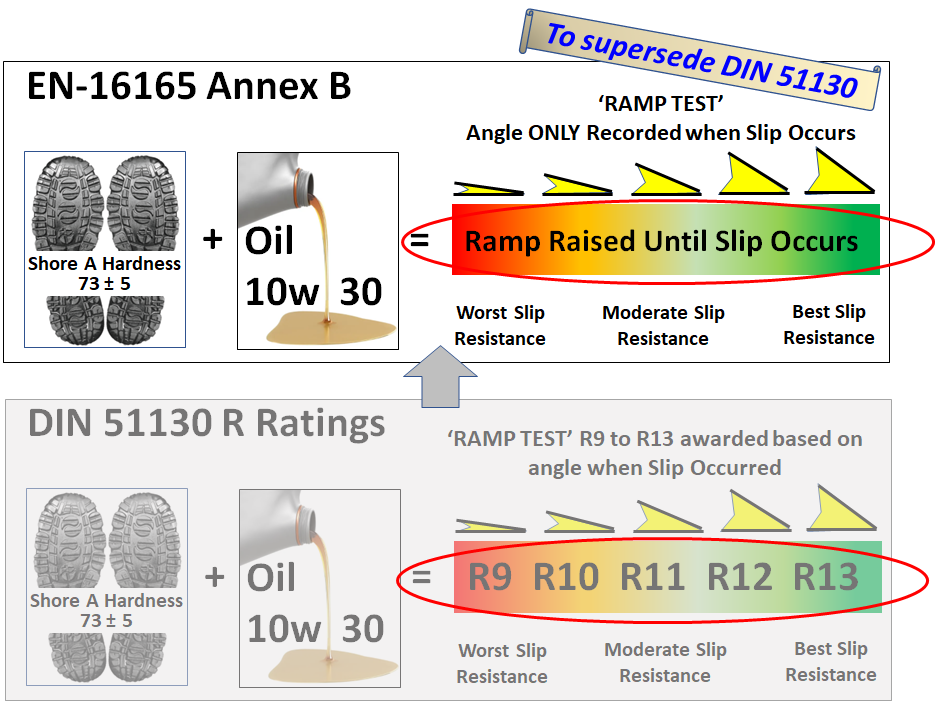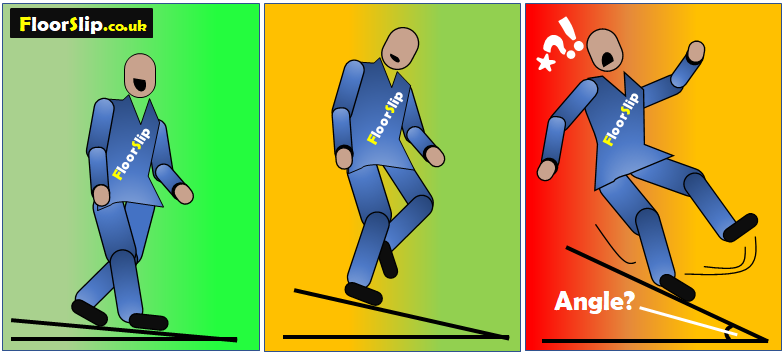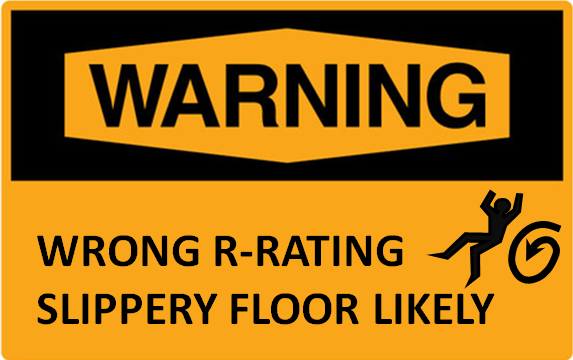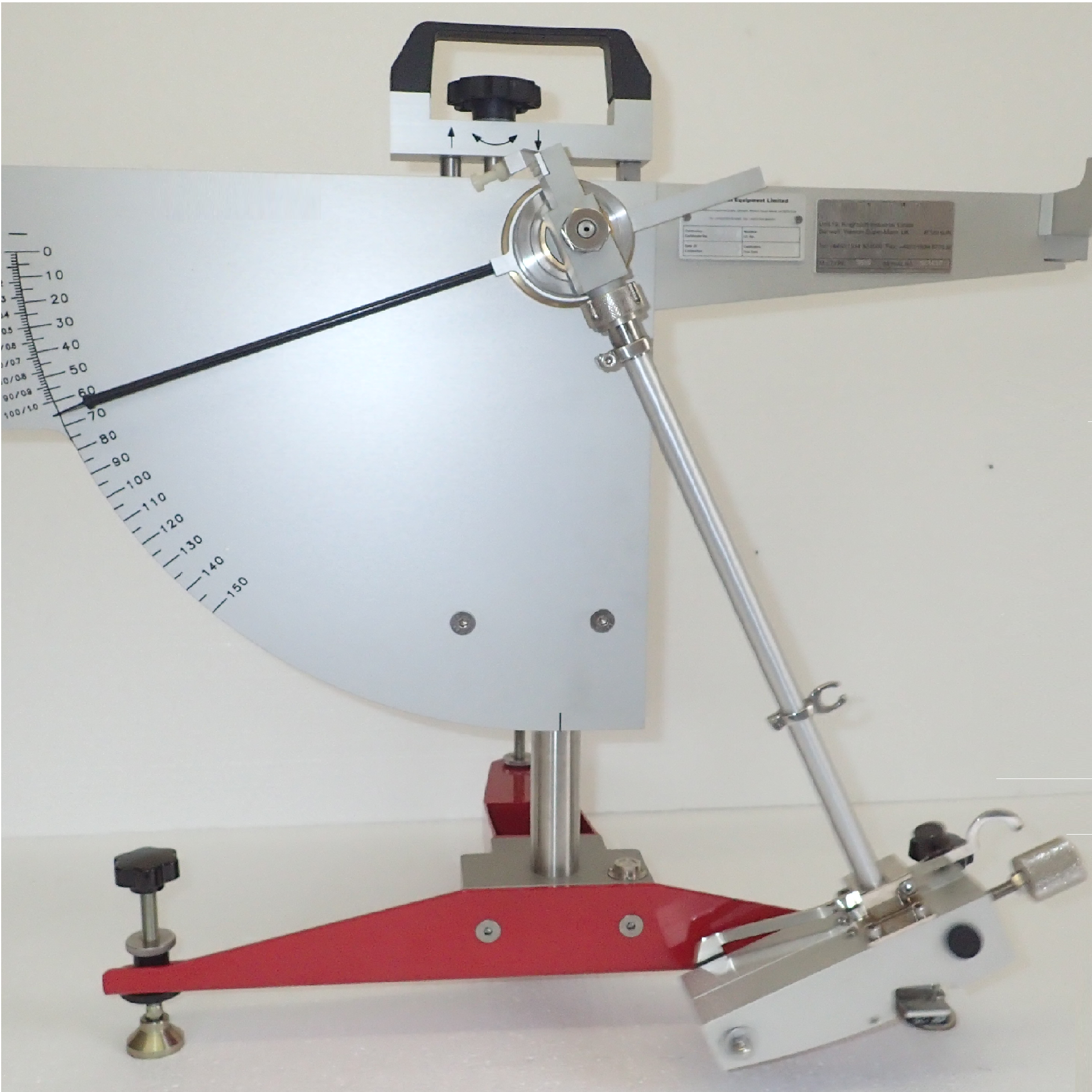Floor R Ratings (Shod Foot)
CAUTION - The R-Rating should NOT be used to specify GENERIC Floor Surfaces; the purpose of the test is for SPECIFIC floors under SPECIFIC Conditions. If you elect to use an R-Rated floor surface, then ALWAYS get it Floor Sample Pendulum Tested to ascertain its TRUE slip resistance in the environment you wish to place it
The R-Rating
The Floor ‘R-Rating’ or 'Ramp Rating' is determined via Ramp Testing. It is carried out when there is a need to assess SPECIFIC flooring under SPECIFIC circumstances to give an indication of the ranges of possible slip resistances. The higher the angle attained during the ramp test, then the more likely that the floor will be able to provide a satisfactory slip resistance surface for Safe Floors That Will Meet UK HSE Standards. But this is ONLY if the Pendulum Test Value (or 'PTV') is also of a suitable value and the Pendulum Floor Test (To Floor Test Standard EN-16165) is the only one recognised in the UK Courts of Law. The Floor Pendulum Test Values is conducted: -
- Either as an On-Site Pendulum Test
- Or an Off-Ste Floor Sample Test.
- Also see Buying New Floors for futher information.
The Floor Pendulum Test Equipment
R-Ratings and DIN 51130 destined to be superseded by EN-16165 Annex B
Up until 2021, under DIN 51130:2014, an angle arrived at during a Ramp Test was given an 'R-Rating' (R9 to R13).However, EN-16165 Annex B, is 'apparently' going to wholly supersede the DIN Standard (to be confirmed). EN-16165 only provides a single angular value test result and no R-Ratings are given. It is an assumption at this time that 'R-Ratings' have been dropped as too many floor specifiers, architects, planners and the like were using R-Ratings to specify floors and as a result, many Claims For Floor Slip Injuries occurred (and are still occurring).

The Floor R-Ratings
The list below shows the R-Ratings under (to be superseded) DIN 51130; this data has been left on this page to give you an idea of how R-Ratings relate to Floor Slip Resistance
- R9-Rating (Worst floor slip resistance; will NOT achieve 36PTV when floor is wet)
- R10-Rating (Marginally better than worst; will NOT achieve 36PTV when floor is wet)
- R11-Rating (Moderate flooring slip resistance; will sometimes achieve 36PTV when floor is wet, but Floor Slopes likely to reduce the 'Target PTV' to below 36PTV)
- R12-Rating (Definitely improving floor slip resistance; will mostly achieve 36PTV when floor is wet, with limited floor slope angles)
- R13-Rating (Best FloorSlip resistance; will always achieve 36PTV at horizontal and reasonable angles of floor slope)
Will the floor achieve at least 36 PTV on a WET or CONTAMINATED Floor in a Pendulum Test?
This 'broadbrush' data is arrived at using past data evaluated by the HSE/HSL in relation to R-Ratings and should be used as a guide only
| Degrees of Ramp Angle Achieved on Test | Would the floor achieve at least 36 PTV on a WET or CONTAMINATED FLOOR in a Pendulum Floor Test? |
| 0° up to 19° | NO |
| 20° up to 27° | In some circumstances only, but Floor Slopes will affect it |
| 28° up to 35° | Probably, but Floor Slopes will affect it |
| Over 35° | More than likely, but Floor Slopes will affect it |
How is the Ramp Test angle arrived at? Why is the Floor Pendulum Test required to Prove a Safe Floor?
The Ramp Testing works by affixing flooring to be tested to a ramp and operators shod with footwear with soles/heels of a very specific pattern and rubber hardness walks backwards and forwards at a slo measured gait along the ramp soaked in motor oil. The ramp is raised to an angle where the operator slips and the angle recorded where the floor slip occurs. The test is repeated several times and the results averaged. The floor is then given a final test result 'angle'.
The Floor Ramp Test increases the floor slope angle until the tester slips to arrive at a Ramp Test Angle

The Problems with R-Ratings / Ramp Angles
Note that there is no accurate Correlation of Floor Ramp Test angle to the Floor Pendulum Test Values (PTV). There has been a lot of misunderstanding and data online in respect to a Read Across from R-Ratings to Pendulum Test Values but this data has been taken out of context and should not be relied upon. Only a Floor Pendulum Test will give you accurate results of Floor Slip Potential
Ramp Testing isn't necessary to proev a floor surface. To save money and reputation, just have Floor-Sample Pendulum Testing carried out; the section Buying New Floors covers this well.
In terms of cost or practicality, worn floors cannot be tested with the Ramp Test either. The mobile On-Site Pendulum Test or Surface Roughness Test can be used for Monitoring Floor Wear
I have been told to specify an R-Rated floor – what advice can you offer?
As the data above tells you, the Floor R-Ratings only give an angle that a floor caused a slip, it did not tell you that the floor was therefore Safe To Prevent Slips
Should you be placed in a position to specify R-Ratings then ALWAYS get a Floor Pendulum Test to meet the HSE and UK Government Requirements for Safe Floors. Also check out our section on Buying New Floors
Ramp Testing is covered by DIN 51130, which has been the main Floor Standard to date for shod feet but expected to be superseded by EN 16165-2021 Determination of Floor Slip Resistance of Pedestrian Surfaces - Methods of Evaluation.
To determine slip resistance properties for continually wet floor environments, like swimming pools – use BS-EN-16165 Annex A (superseding in 2021 DIN 51097: 2014 ABC Ratings).

